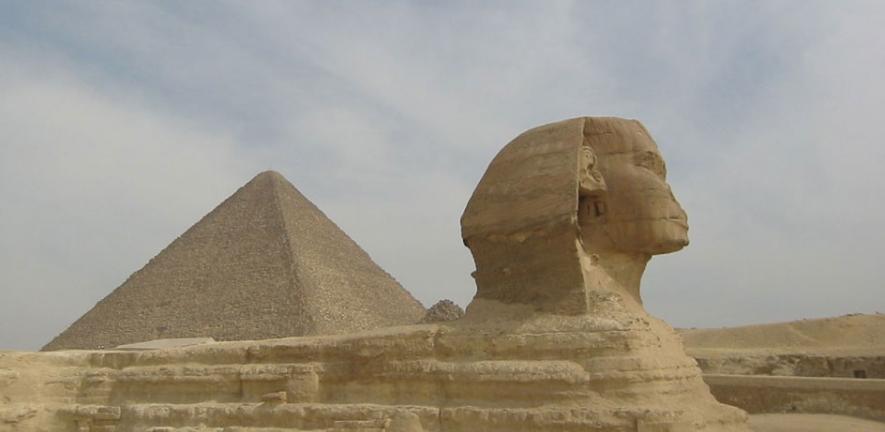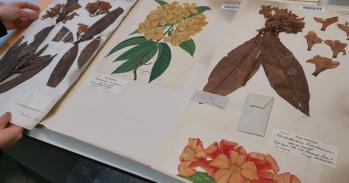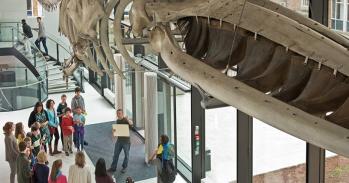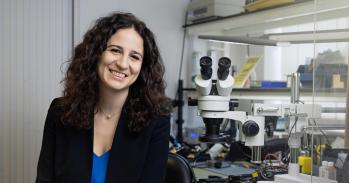
The project Accessing Virtual Egypt is breaking new ground in knowledge transfer between museums and prisons, with empowering results
The project Accessing Virtual Egypt is breaking new ground in knowledge transfer between museums and prisons, with empowering results
Many of the prisoners were serving long sentences and asked whether there was a way I could bring the museum to them more directly.
Dr Sally-Ann Ashton
A pioneering programme is enabling prisoners to unlock the secrets of the past as part of an initiative to improve their prospects for the future. For the past five years, Dr Sally-Ann Ashton, Curator of the Egyptian Collection at The Fitzwilliam Museum, has taken her knowledge of ancient Egypt into prisons, working closely with prisoners and prison education departments. The study of ancient Egypt is being used as a means of inspiring learning through literacy, numeracy and art at several prisons including HMP Edmunds Hill. These new skills have also supported many prisoners of North African descent in exploring their own cultural heritage.
"Many of the prisoners were serving long sentences and asked whether there was a way I could bring the museum to them more directly", said Dr Ashton. The idea they came up with was a Virtual Gallery – something they could access on computers in the prison and then carry on using when they are released.
As the idea grew, Dr Ashton realised she needed to spend more time in prison. Winning an AHRC Knowledge Transfer (KT) Fellowship in 2007, one of the first 12 to be awarded, has allowed Dr Ashton to do just this: "I needed to find out at first hand what the important issues are for educating people serving different lengths of sentences and I needed to work with prison education departments to see how new resources could complement building basic reading and writing skills".
The KT Fellowship scheme is designed to support academics who would like to embark on a programme of knowledge transfer that will make a significant difference beyond the world of academia. As Dr Ashton explained, it was important that any new resources should have as wide a benefit as possible: I wanted to do something that was sustainable and could reach potentially all of the prison population, as well as the wider public.
Among other resources, one outcome of the KT Fellowship will be the Virtual Gallery, which was funded by the Heritage Lottery Fund (HLF) and is due to be launched later in 2008. The look and feel of this facility – a virtual walk through the real museum, allowing the user to stop at any of the cabinets and examine the artefacts – has been driven entirely by the prisoners. They wanted a resource that looked both like a computer game and the outside world. The result is the nearest thing we thought you could get to being in the gallery yourself.
Dr Ashton views the exchange of knowledge as very much two-way: They are a very inspiring audience. Their questions often make me go back and re-think, and I m looking at my own subject quite differently as a consequence. By evaluating the impact of her work during the Fellowship, Dr Ashton hopes to arrive at a clearer idea of the best way museums can contribute to society through prison education.
For more information, please contact Dr Sally-Ann Ashton (sa337@cam.ac.uk).
Arts and Humanities Research Council
The Arts and Humanities Research Council (AHRC) supports research within a wide subject domain, from traditional subjects such as history, modern languages and English literature, through to the creative and performing arts.
Established in April 2005 from the Arts and Humanities Research Board (AHRB), the AHRC has an annual budget of around £90 million to fund research and postgraduate study, as well as museums and galleries associated with higher education establishments. In 2006–2007, the value of awarded grants to the University of Cambridge was £4 million.
The AHRC recognises not only the importance of sustaining the arts and humanities research base, but also of ensuring that the knowledge and understanding it generates is widely disseminated. The two Cambridge projects highlighted here – the Shahnama Project and Accessing Virtual Egypt – address this strategic priority in different ways. Indeed, the Council has established itself as a leading authority on research-based knowledge transfer (KT), with several new initiatives (including the KT Fellowship) launched specifically for the AHRC research community. Because the AHRC’s definition of KT is broad and flexible in implementation, its impact has extended to key societal and economic challenges.
Several new strategic initiatives have been planned for 2007–2008. In 2007, the AHRC launched a joint £5m programme on Religion and Society with the Economic and Social Research Council (ESRC) and a £5.5 million programme entitled Beyond Text: Performances, Sounds, Images, Objects. In 2008, work will begin with the Engineering and Physical Sciences Research Council (EPSRC) on a Science and Heritage programme.
Alongside research grant activities, strategic programmes and KT, the AHRC is keen to highlight another priority: the support of postgraduate and early career researchers to protect the long-term sustainability and health of the UK’s arts and humanities research. A recent survey showed that 74% of AHRC award holders go on to pursue academic and research careers, with the majority of others pursuing careers in creative and cultural sectors, non-profit organisations and public services.
This work is licensed under a Creative Commons Licence. If you use this content on your site please link back to this page.





